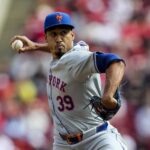
Shogo Akiyama
Position: CF
Bats/Throws: L/R
Age: April 16, 1988 (31)
Stats (Japan Pacific League): .303/.392/.471, 31 2B, 4 3B, 20 HR, 62 RBI, 62 RBI, 12 SB, 8 CS
With the Nippon Professional Baseball League confirming he is a free agent, Akiyama has a decision to make. There are overtures the Seibu Lions and other Japanese baseball teams will make lucrative long terms offers to entice him to stay in Japan. What we do not know is whether that will entice him to stay in Japan over pursuing a shot at proving he could play at the Major League level.
On that front, Akiyama played in the 2017 World Baseball Classic. In four games played, he was 3-for-1o with a run, walk, two RBI, and a stolen base. While an interesting note, this is a small sample size which does not prove he can play at the Major League level.
Over the years, we have seen players like Ichiro Suzuki and Hideki Matsui thrive while fellow Japanese outfielders like Tsuyoshi Shinjo and Kosuke Fukudome failed. With respect to Ichiro, it should be noted Akiyama holds the NPB single season hit record which once belonged to the future Hall of Famer.To best Ichiro, you know Akiyama has exceptional bat control.
https://twitter.com/npbtracker/status/1181434040051802112?s=20
After that 2015 season, Akiyama would develop more power with 30+ doubles, 4+ triples, and 20+ homers in each of the past three seasons. That has seen him have a corresponding increase in his strikeout rate, but it should be noted his 14.9 percent strikeout rate is still quite good. More importantly, he did not see a drop in his walk rate. In fact, it has improved with his 8.9 percent rate in 2015 increasing to a very good 11.2 percent over the past three years.
The caution with Akiyama is he is turning 32 next year arguably putting him in the final year of his prime. We have seen him slip a bit offensively with his having his second-worst OPS over the past five years. Still, even without the power, it is possible he could adapt to become a Jeff McNeil type of hitter as he ages where he sprays the ball all over the field to accumulate hit after hit.
The issue with Akiyama probably won’t be his offense, but rather his defense. According to Jim Allen, who in some ways is the NBP’s answer to Bill James, wrote on his site jballallen.com, Akiyama ” is not slow, but now he’s just better than average.” That slip in his speed led to his not only not being able to be as much of a stolen base threat, but it also contributed to him struggling in center this past season. That’s a steep drop for a five-time Gold Glove winner.
Overall, Akiyama is a talented player, but he is not without his red flags. He’s a player who is at the end of his prime, and we have seen his power, speed, and defense decline a bit. However, that does not mean he will not be a valuable player who can be relied upon to contribute in 2020 and some of the ensuing years. The challenge for a team interested is determining just how long he can be an everyday player at the Major League level.
Contract
It is very difficult to peg what type of contract Akiyama will receive this offseason because there are many factors at play including his marketability in Japan as well as the depression of the free-agent market we have seen the past few seasons.
To take an imperfect comparable, Michael Brantley signed a two year $32 million deal with the Houston Astros this offseason. Brantley earned that contract after having a healthy 2018 season after three injury-plagued seasons. On the one hand, teams knew Brantley was an All-Star caliber player when healthy. On the other, he was rarely that, and expecting him to be that at 32 didn’t inspire trust among many teams. Still, he would prove to be healthy this year, and the Astros were the beneficiaries of that.
You could argue Akiyama on a two year deal with an average annual value at or above $16 million is well worth the risk. In terms of annual average value, it may prove to be much more than any Japanese team could offer, especially when the largest contract in league history was given to closer Tomoyuki Sugano, who received a deal worth an average annual value of $5.7 million over three years.
Still, teams like the Lions or other Japanese league teams could offer longer-term deals than what Major League teams may want to offer. In the end, that makes the contract discussions between Akiyama and all teams very complicated.
Recommendation
The Mets are a team in real need for a center fielder, but there are real questions over whether Akiyama is still a center fielder. If not, that leaves the Mets with yet another left-handed hitting corner outfielder who is arguably no better than Brandon Nimmo or Michael Conforto. Of course, both Nimmo and Conforto have center field experience creating the possibility you could fit all three in the outfield much like the team did when they have McNeil playing left field.
If the Mets could get Akiyama on a Brantley like discount, they should pursue him. However, with teams like the Cubs, Giants, and Mariners likely interested, that is not going to happen. As a result, the Mets should probably look to address center field in another way while using their offseason budget to really tackle their bullpen and rotation issues.















